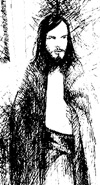
By Anthony McIntyre
Around two years ago I was interviewed by Martin Lynch in Belfast’s John Hewitt bar. He was laying the founds for the Chronicles of Long Kesh. As one of the former denizens of the then sprawling news magnet I can readily testify to the forensic mind Lynch brought to the task. His probing unearthed long forgotten nuggets from a distant past which reduced both of us to uncontrollable fits of laughter over pints of beer. He couldn’t believe what I was telling him and I couldn’t believe I was telling it.
That was much of what Long Kesh was about -- laughter. When Bobby Sands famously said that revenge would be the laughter of our children, he may have been inspired by the laughter he witnessed behind the walls even in the worst of circumstances.
Laughter overcomes a lot, including the delight a malign adversary derives from his nefariousness.
In 1980 when a naked Tony Miller from Derry laughed in the face of a screw who had been kicking him, all of his comrades banged up along the blanket wing knew who emerged the victor from that exchange.
There is a freedom in laughter. Frequently the most psychologically liberating moments in the prison arrived via laughter. And there are lots in this play for an audience to laugh about. Humour is its strongest feature.
The story of Long Kesh is a challenging one to chronicle. For three decades it formed a stage where deaths, escapes, riots, burnings, protests and violence were the major acts viewed by a large audience.
Can such an incident-packed and prolonged time span be adequately explored in the form of a play?
And, to boot, a play deprived of props relying entirely on the power of performance to deliver.
A film is perhaps a better medium, even more so a book. The hiatuses and silences that need plugged are pretty expansive.
For the historian in the audience and her companion, the devotee of detail, the playwright might just, to borrow a phrase, have extended his reach at the expense of his grasp.
Yet this must be qualified by recognition that there is a tendency on the part of those who live through or have been deeply affected by any event to want it reproduced exactly as they recall it. No depiction can manage this. To expect that it should is to ignore the licence that so distinguishes art from science.
With Oscar, Toot, Eamon, Hank and Thumper forming the prison population, acuity was enhanced by having the story of Long Kesh narrated by Freddie Gillespie, a prison officer.
His tale insinuated how a battle ground could become a bottle ground. Freddie, like so many in his keep, survived the battle but not the bottle. As narrator, it fell to him to join the dots that an audience less familiar with the jail scene might have difficulty placing in any intelligible context.
It is hard to see how it might succeed otherwise. The play is predicated on the audience’s familiarity with events.
The bizarre musical outbursts only have meaning if grounded in that familiarity, outside of which the play is rapidly reduced to cabaret sustained by a series of charades.
During the blanket protest nocturnal sing songs were one of the limited ways of putting the evening in. They were also used after a particularly bad wing shift to show that despite regime brutality the spirits had not been broken.
The acting is superb as it deftly manoeuvred between the two levels at which the play operated.
At the surface there were the stern-faced soldiery drillers in the parade ground where feet were hammered against the ground and heads yanked to the side in response to barked military commands.
This was the controlled martial backdrop that the political prisoners sought to drape behind their stage.
At another level, chronicled was life as it was lived by prisoners in the cells and huts that spawned the marshy ground on which the prison was built: banter, trauma, emotions, hypochondria, chicken choking and depression.
If there was one thing the play failed to capture it was the pervasive thought control that insidiously gnawed away at the autonomy of intellectual life within the prison.
For sure it produced writers and artists but the controlled environment also allowed it to throw up the nemesis of art, the censor. The screws censored the prisoners and the prisoners censored their own.
In the end one scene followed me home; where two blanket prisoners took to lying on the floor conversing through the pipes to each other.
For two years during the no wash protest before he was moved, Martin Livingstone and I in adjoining cells, audible but invisible to each other, would assume the prone position and chat about every nonsense under a sun we never got to see. It was darkness at noon, every noon.
![[Irish Republican News]](https://republican-news.org/graphics/title_gifs/rn.gif)
![[Irish Republican News]](https://republican-news.org/graphics/title_gifs/harp.gif)

